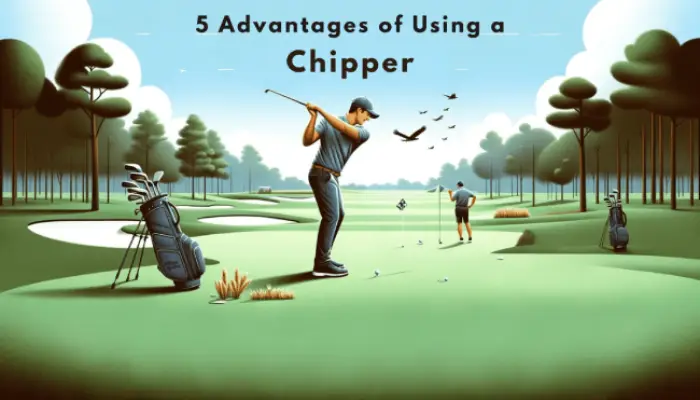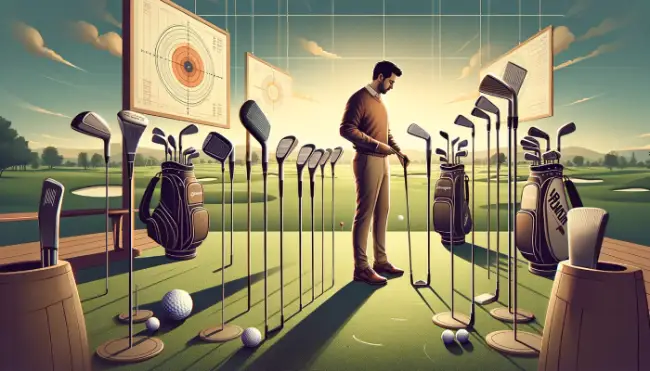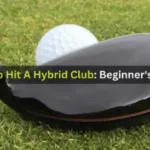Golf is a sport filled with rules and regulations, and as a player, it’s important to understand and adhere to them. One common debate among golfers is: Are chippers legal in golf? If you’ve been curious about this topic and are unsure of the answer, you’ve come to the right place.
Are Chippers Legal in Golf?
Chippers are legal in golf, but they must conform to specific rules set by the United States Golf Association (USGA) and the R&A to be permissible for use in official competitions.
Here are the key criteria that chippers must meet to be considered legal:
One Striking Face
The chipper must have only one striking face, similar to any other golf club except putters. This means that a chipper with two striking faces, resembling a putter, would not be allowed.
Maximum Length
The chipper must adhere to the maximum club length rules to prevent them from becoming excessively long, which could potentially give golfers an unfair advantage. The maximum allowable length for a chipper is 48 inches for all clubs except putters.
Clubhead
The USGA’s rules for the clubhead state that it must be rigid, stable, and functional. Irons (including chippers) also cannot have graphics that assist with aim.
Loft Angle
Chippers should have a loft angle greater than 10 degrees. This loft angle requirement distinguishes them from putters, which typically have less loft. This characteristic ensures that chippers are designed for lifting the ball off the ground, which is essential for chip shots.
Grip
The USGA’s regulations for grip state that all irons must have a single grip with a circular cross-section. This differs from the putter, which can have a non-circular cross-section. So be careful with your chipper.

5 Advantages of Using a Chipper
Using a chipper in golf presents several advantages that can significantly enhance a player’s short game, especially around the greens where accuracy and control are paramount.
- Improved Accuracy and Control: The chipper is made so that you can hit the ball like you would with a putter, which is generally easier to control than a full swing with a wedge. This makes short shots more accurate, which is especially helpful for players who have trouble with chipping yips or making steady contact with traditional wedges.
- Consistency: The chipper’s wide sole and loft are designed to minimize turf interaction, which can help produce more consistent shot outcomes. This is especially beneficial on tight lies or in situations where the grass is against the grain, where a traditional wedge might dig or catch, leading to poor shots.
- Simplified Decision Making: Having a chipper in the bag can simplify club selection around the greens. Instead of debating between various wedges and trying to adjust swing length and power, players can opt for the chipper for a straightforward, repeatable shot. This can speed up play and reduce mental strain during a round.
- Versatility: Even though chippers are mostly used for chipping, some players find them useful for longer bump-and-run shots or even getting out of light rough because they are so flexible and easy to use. This versatility can be a boon for recreational golfers looking to improve their scores without complicating their game.
- Learning and Transition Tool: For beginners or high-handicappers, a chipper can serve as a valuable learning tool, helping to develop a sense of distance and direction control. It can also act as a bridge as players work to improve their skills with more traditional clubs.

When and How to Use a Chipper Effectively
Understanding when and how to use a chipper effectively can significantly enhance your short game and overall performance on the golf course. Here, we’ll explore strategic scenarios for chipper use and techniques to maximize its benefits.
Strategic Scenarios for Chipper Use: Distances and Conditions
- Around the Green: Chippers shine when you are just off the green, facing distances that are too long for a putter but too short for a full wedge shot. Use your chipper when you need precision and control to get the ball close to the hole.
- Tight Lies: Chippers are particularly effective on tight lies or hard fairway conditions. Their lofted face allows you to lift the ball cleanly over the grass or rough, reducing the risk of thin or fat shots.
- Chipping over Hazards: When you need to carry a bunker or other hazard close to the green, a chipper’s design can help you execute a low-flying shot with confidence, ensuring the ball lands softly.
Techniques for Maximizing Chipper Benefits
- Putting-Style Stroke: Use a putting-style stroke when using a chipper. Position the ball slightly back in your stance, lean the shaft forward, and maintain a steady, pendulum-like motion. This technique promotes consistency and control.
- Practice and Experiment: Spend time practicing with your chipper to become familiar with its performance. Experiment with different clubs for various chip shots, and learn how the ball reacts with each one. This will help you gauge distance and choose the right club for each situation.
- Maintain a Relaxed Grip: Avoid gripping the chipper too tightly. A relaxed grip encourages a smoother stroke, improving your feel and touch around the greens.

How to Choose the Right Chipper
Selecting the right chipper is crucial for optimizing your short game performance. Several factors come into play when making this decision, including the loft angle, shaft length, and head design.
Here are some key considerations and recommendations based on different skill levels and playing styles:
Loft Angle
The loft angle of a chipper is a critical factor in determining the trajectory and distance of your chip shots. Chipper loft angles typically range between 30 to 37 degrees.
- Higher Loft (e.g., 36-37 degrees): Chippers with higher loft angles are ideal for golfers who want to maximize loft and minimize roll. They work well in situations where you need to carry the ball over obstacles or rough terrain before it lands on the green.
- Mid-Range Loft (e.g., 32-35 degrees): These chippers offer versatility and are suitable for various chip shots. They provide a balance between loft and roll, making them a good choice for golfers looking for an all-around chipper.
- Lower Loft (e.g., 30-31 degrees): Chippers with lower loft angles are excellent for bump-and-run shots. They produce less loft and more roll, making them suitable for firm, fast greens and situations where you want the ball to roll out after landing.
Shaft Length
The right shaft length is essential for comfort and accuracy. Generally, chippers have a shaft length similar to that of a putter, facilitating a putting-like stroke.
Players should choose a shaft length that complements their stance and height, ensuring a natural, upright posture that reduces strain on the back and shoulders. Taller players may require a slightly longer shaft, while shorter players might benefit from a shorter one. Testing different lengths can help determine the most comfortable fit.
Head Design
The design of the chipper’s head influences its forgiveness and suitability for various playing conditions.
A wider sole can improve performance on tight lies or heavy rough by preventing the club from digging into the turf. In contrast, a narrower sole might offer better control for skilled players. The head’s shape and alignment aids can also contribute to better targeting and confidence on short shots.
Recommendations:
- Beginners: Opt for a chipper with a higher loft (around 35-37 degrees), a comfortable shaft length that matches your putting stance, and a forgiving head design with a wide sole and prominent alignment aids.
- Intermediate Players: Consider a chipper with a mid-range loft (32-34 degrees), a shaft length that ensures a comfortable and accurate stroke, and a head design that offers a balance between forgiveness and control.
- Advanced Players: Advanced players might prefer a chipper with a lower loft (30-32 degrees) for more control and less bounce, a shaft length that complements their precise short game stance, and a sleeker head design for optimal feedback and versatility on various shots.
Ultimately, the right chipper for you depends on your skill level, preferences, and the types of shots you encounter on the golf course. Trying out different models and seeking guidance from a golf professional can help you make an informed decision.
FAQ
Q: Are chippers legal to use in golf competitions?
A: Yes, chippers are legal to use in golf competitions, provided they conform to the rules set by the governing bodies of golf, such as the United States Golf Association (USGA) and The R&A. These rules pertain to club design, including aspects like the loft, the lie, and the construction of the clubhead.
Q: Can a chipper have two striking faces?
A: No, according to the Rules of Golf, a club cannot have two striking faces. A chipper must have only one striking face to be considered legal for play. Clubs with two striking faces are deemed non-conforming.
Q: Is there a limit to the number of clubs I can carry during a round, and does a chipper count towards this limit?
A: Yes, the maximum number of clubs you are allowed to carry in your bag during a round is 14, according to the Rules of Golf. A chipper counts as one of these clubs if you choose to include it in your bag.
Q: Can you use a chipper on the green?
A: Yes, you can use a chipper on the green. Chippers are designed for shots around the green, where precision and control are crucial. They are especially useful for situations where using a putter may not provide the required loft or where obstacles need to be cleared.
Q: Do professional golfers use chippers?
A: While it’s rare to see professional golfers use chippers, as they typically have a high level of skill with wedges and prefer the versatility those clubs offer, some recreational and amateur golfers find chippers beneficial for their short game.







